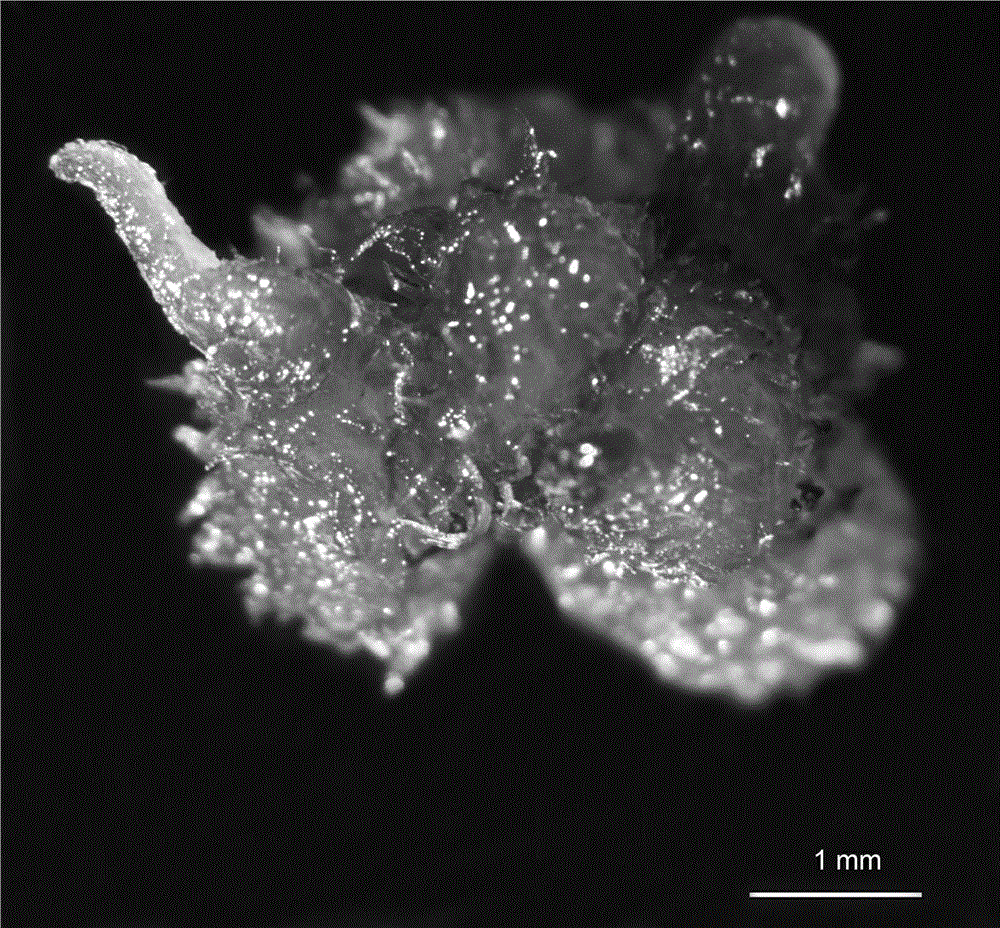Green globular body tissue culture propagation method for Alsophila costularis
A technology of green spheroids and cypress, which is applied in the field of plant tissue culture to achieve the effects of high proliferation rate and high reproductive efficiency
- Summary
- Abstract
- Description
- Claims
- Application Information
AI Technical Summary
Problems solved by technology
Method used
Image
Examples
Embodiment 1
[0040] Embodiment 1 The inventive method
[0041] (1) Acquisition of sterile explants of C. sinensis
[0042] Inoculate the sterile spores of Cymbidium sinensis on the medium of 1 / 4MS + 30.0g / L sucrose + 7.0g / L agar, pH 5.80, the culture conditions are: 20~25℃, the light time is 12 hours per day, and the light intensity is 2000lx, to obtain young tender aseptic seedlings. In the ultra-clean workbench, the obtained sterile seedlings were peeled off the shoot tips with tweezers under a dissecting microscope, and the shoot tips were used as sterile explants induced by the green spheroids of C. sinensis.
[0043] The method for obtaining aseptic spores of Cylathelus sinensis is as follows: put 10 mg of spores in a 1.5ml centrifuge tube, soak in sterile water for 1 to 2 hours, centrifuge at 6000r / min for 2 minutes to obtain spore precipitates, and add 5% NaClO solution Sterilize for 4 minutes, and wash with sterile water for 3-5 times to obtain sterile spores of C. sinensis.
[...
Embodiment 2
[0062] Embodiment 2 and embodiment 3 are the method of the present invention
[0063] Example 2 and Example 3 except that the concentration of each component in each culture medium listed in Table 1 is different, other measures are the same as Example 1, and will not be repeated.
[0064] The difference between the steps of Table 1 Embodiment 2-Embodiment 3 and Embodiment 1
[0065]
[0066]
[0067] The propagation result of embodiment 1: the induction rate of green spheroid is 88%, the differentiation rate is 100%, and the rooting rate is 100%, that is, the formation rate of tissue cultured shoots is 100%, rooted and cultivated for 28 days, and the average height of tissue cultured shoots is 2.87cm . The green spheroid with a diameter of 2mm has a fresh weight of 10 mg, and the average fresh weight of the green spheroid increases by 75 mg every 21 days, and the multiplication factor is about 7.5 times. The obtained green spheroids are intermediate propagules, which a...
Embodiment 3
[0069] The propagation result of embodiment 3: the induction rate of green spheroid is 82%, and the differentiation rate is 100%, and the rooting rate is 100%, that is, the formation rate of tissue cultured shoots is 100%, rooted and cultivated for 28 days, and the average height of tissue cultured plants is 2.70cm . The green spheroid with a diameter of 2mm has a fresh weight of 10 mg, and the average fresh weight of the green spheroid increases by 83.67 mg every 21 days, and the multiplication factor is about 8.4 times. The obtained green spheroid is an intermediate propagule, which undergoes two-step multiplication culture for 42 days, differentiation culture for 28 days, rooting culture to form tissue culture seedlings for 28 days, and propagation time for 98 days.
[0070] A 1-3 mm green spheroid can be differentiated once to obtain 20-25 tissue cultured seedlings.
PUM
 Login to View More
Login to View More Abstract
Description
Claims
Application Information
 Login to View More
Login to View More - R&D
- Intellectual Property
- Life Sciences
- Materials
- Tech Scout
- Unparalleled Data Quality
- Higher Quality Content
- 60% Fewer Hallucinations
Browse by: Latest US Patents, China's latest patents, Technical Efficacy Thesaurus, Application Domain, Technology Topic, Popular Technical Reports.
© 2025 PatSnap. All rights reserved.Legal|Privacy policy|Modern Slavery Act Transparency Statement|Sitemap|About US| Contact US: help@patsnap.com



